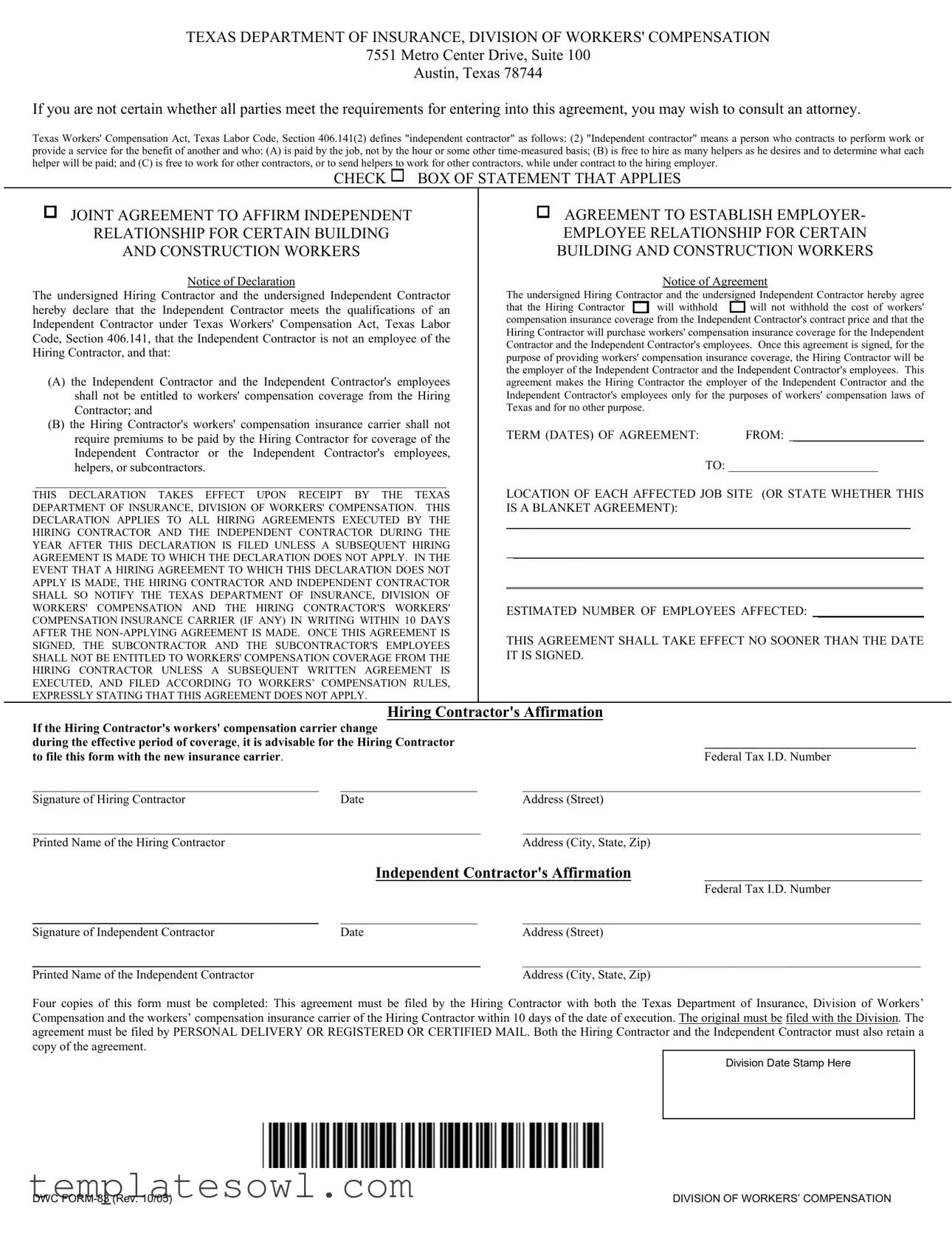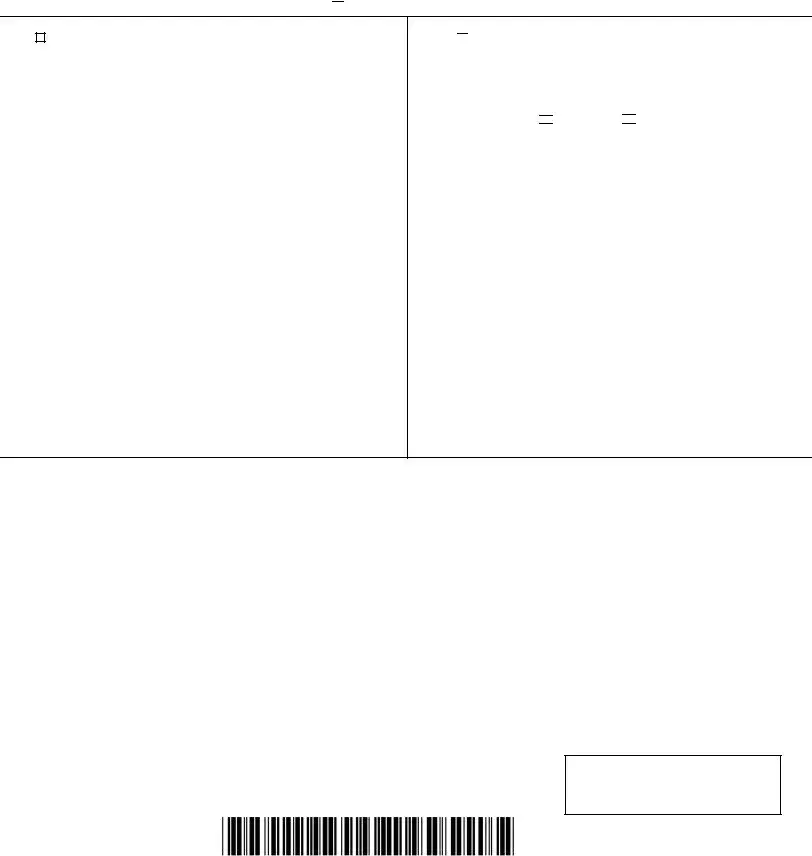TEXAS DEPARTMENT OF INSURANCE, DIVISION OF WORKERS' COMPENSATION
7551 Metro Center Drive, Suite 100
Austin, Texas 78744
If you are not certain whether all parties meet the requirements for entering into this agreement, you may wish to consult an attorney.
Texas Workers' Compensation Act, Texas Labor Code, Section 406.141(2) defines "independent contractor" as follows: (2) "Independent contractor" means a person who contracts to perform work or
provide a service for the benefit of another and who: (A) is paid by the job, not by the hour or some other time-measured basis; (B) is free to hire as many helpers as he desires and to determine what each helper will be paid; and (C) is free to work for other contractors, or to send helpers to work for other contractors, while under contract to the hiring employer.
CHECK 
 BOX OF STATEMENT THAT APPLIES
BOX OF STATEMENT THAT APPLIES
JOINT AGREEMENT TO AFFIRM INDEPENDENT
RELATIONSHIP FOR CERTAIN BUILDING
AND CONSTRUCTION WORKERS
Notice of Declaration
The undersigned Hiring Contractor and the undersigned Independent Contractor hereby declare that the Independent Contractor meets the qualifications of an Independent Contractor under Texas Workers' Compensation Act, Texas Labor Code, Section 406.141, that the Independent Contractor is not an employee of the Hiring Contractor, and that:
(A)the Independent Contractor and the Independent Contractor's employees shall not be entitled to workers' compensation coverage from the Hiring Contractor; and
(B)the Hiring Contractor's workers' compensation insurance carrier shall not require premiums to be paid by the Hiring Contractor for coverage of the Independent Contractor or the Independent Contractor's employees,
helpers, or subcontractors.
__________________________________________________________________
THIS DECLARATION TAKES EFFECT UPON RECEIPT BY THE TEXAS DEPARTMENT OF INSURANCE, DIVISION OF WORKERS' COMPENSATION. THIS DECLARATION APPLIES TO ALL HIRING AGREEMENTS EXECUTED BY THE HIRING CONTRACTOR AND THE INDEPENDENT CONTRACTOR DURING THE YEAR AFTER THIS DECLARATION IS FILED UNLESS A SUBSEQUENT HIRING AGREEMENT IS MADE TO WHICH THE DECLARATION DOES NOT APPLY. IN THE EVENT THAT A HIRING AGREEMENT TO WHICH THIS DECLARATION DOES NOT APPLY IS MADE, THE HIRING CONTRACTOR AND INDEPENDENT CONTRACTOR SHALL SO NOTIFY THE TEXAS DEPARTMENT OF INSURANCE, DIVISION OF WORKERS' COMPENSATION AND THE HIRING CONTRACTOR'S WORKERS' COMPENSATION INSURANCE CARRIER (IF ANY) IN WRITING WITHIN 10 DAYS AFTER THE NON-APPLYING AGREEMENT IS MADE. ONCE THIS AGREEMENT IS SIGNED, THE SUBCONTRACTOR AND THE SUBCONTRACTOR'S EMPLOYEES SHALL NOT BE ENTITLED TO WORKERS' COMPENSATION COVERAGE FROM THE HIRING CONTRACTOR UNLESS A SUBSEQUENT WRITTEN AGREEMENT IS EXECUTED, AND FILED ACCORDING TO WORKERS’ COMPENSATION RULES, EXPRESSLY STATING THAT THIS AGREEMENT DOES NOT APPLY.

 AGREEMENT TO ESTABLISH EMPLOYER- EMPLOYEE RELATIONSHIP FOR CERTAIN BUILDING AND CONSTRUCTION WORKERS
AGREEMENT TO ESTABLISH EMPLOYER- EMPLOYEE RELATIONSHIP FOR CERTAIN BUILDING AND CONSTRUCTION WORKERS
Notice of Agreement
The undersigned Hiring Contractor and the undersigned Independent Contractor hereby agree
that the Hiring Contractor 
 will withhold
will withhold 
 will not withhold the cost of workers' compensation insurance coverage from the Independent Contractor's contract price and that the Hiring Contractor will purchase workers' compensation insurance coverage for the Independent Contractor and the Independent Contractor's employees. Once this agreement is signed, for the purpose of providing workers' compensation insurance coverage, the Hiring Contractor will be the employer of the Independent Contractor and the Independent Contractor's employees. This agreement makes the Hiring Contractor the employer of the Independent Contractor and the Independent Contractor's employees only for the purposes of workers' compensation laws of Texas and for no other purpose.
will not withhold the cost of workers' compensation insurance coverage from the Independent Contractor's contract price and that the Hiring Contractor will purchase workers' compensation insurance coverage for the Independent Contractor and the Independent Contractor's employees. Once this agreement is signed, for the purpose of providing workers' compensation insurance coverage, the Hiring Contractor will be the employer of the Independent Contractor and the Independent Contractor's employees. This agreement makes the Hiring Contractor the employer of the Independent Contractor and the Independent Contractor's employees only for the purposes of workers' compensation laws of Texas and for no other purpose.
TERM (DATES) OF AGREEMENT: |
FROM: _____________________ |
|
TO: ________________________ |
LOCATION OF EACH AFFECTED JOB SITE (OR STATE WHETHER THIS IS A BLANKET AGREEMENT):
_________________________________________________________________
__________________________________________________________________
___________________________________________________________________
ESTIMATED NUMBER OF EMPLOYEES AFFECTED: _________________
THIS AGREEMENT SHALL TAKE EFFECT NO SOONER THAN THE DATE IT IS SIGNED.
Hiring Contractor's Affirmation
If the Hiring Contractor's workers' compensation carrier change |
|
during the effective period of coverage, it is advisable for the Hiring Contractor |
__________________________________ |
to file this form with the new insurance carrier. |
|
Federal Tax I.D. Number |
______________________________________________ |
______________________ |
________________________________________________________________ |
Signature of Hiring Contractor |
Date |
Address (Street) |
________________________________________________________________________ |
________________________________________________________________ |
Printed Name of the Hiring Contractor |
|
Address (City, State, Zip) |
|
Independent Contractor's Affirmation |
____________________________ |
|
|
|
Federal Tax I.D. Number |
______________________________________________ |
______________________ |
________________________________________________________________ |
Signature of Independent Contractor |
Date |
Address (Street) |
|
________________________________________________________________________ |
________________________________________________________________ |
Printed Name of the Independent Contractor |
|
Address (City, State, Zip) |
|
Four copies of this form must be completed: This agreement must be filed by the Hiring Contractor with both the Texas Department of Insurance, Division of Workers’ Compensation and the workers’ compensation insurance carrier of the Hiring Contractor within 10 days of the date of execution. The original must be filed with the Division. The agreement must be filed by PERSONAL DELIVERY OR REGISTERED OR CERTIFIED MAIL. Both the Hiring Contractor and the Independent Contractor must also retain a copy of the agreement.
Division Date Stamp Here
DWC FORM-83 (Rev. 10/05) |
DIVISION OF WORKERS’ COMPENSATION |



 BOX OF STATEMENT THAT APPLIES
BOX OF STATEMENT THAT APPLIES
 AGREEMENT TO ESTABLISH EMPLOYER- EMPLOYEE RELATIONSHIP FOR CERTAIN BUILDING AND CONSTRUCTION WORKERS
AGREEMENT TO ESTABLISH EMPLOYER- EMPLOYEE RELATIONSHIP FOR CERTAIN BUILDING AND CONSTRUCTION WORKERS
 will withhold
will withhold 
 will not withhold the cost of workers' compensation insurance coverage from the Independent Contractor's contract price and that the Hiring Contractor will purchase workers' compensation insurance coverage for the Independent Contractor and the Independent Contractor's employees. Once this agreement is signed, for the purpose of providing workers' compensation insurance coverage, the Hiring Contractor will be the employer of the Independent Contractor and the Independent Contractor's employees. This agreement makes the Hiring Contractor the employer of the Independent Contractor and the Independent Contractor's employees only for the purposes of workers' compensation laws of Texas and for no other purpose.
will not withhold the cost of workers' compensation insurance coverage from the Independent Contractor's contract price and that the Hiring Contractor will purchase workers' compensation insurance coverage for the Independent Contractor and the Independent Contractor's employees. Once this agreement is signed, for the purpose of providing workers' compensation insurance coverage, the Hiring Contractor will be the employer of the Independent Contractor and the Independent Contractor's employees. This agreement makes the Hiring Contractor the employer of the Independent Contractor and the Independent Contractor's employees only for the purposes of workers' compensation laws of Texas and for no other purpose.